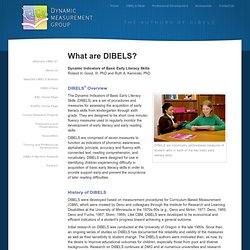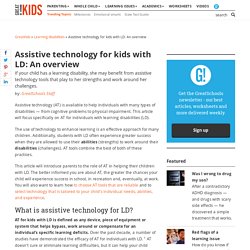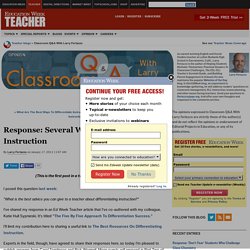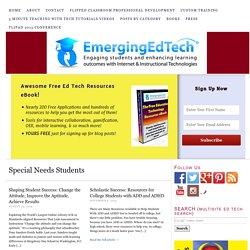

Disabilities - My Child's Special Needs - Parents - ED.gov. What are DIBELS®? Roland H.

Good, III, PhD and Ruth A. Kaminski, PhD DIBELS® Overview DIBELS are individually administered measures of student skills in each of the key basic early literacy skills. The Dynamic Indicators of Basic Early Literacy Skills (DIBELS) are a set of procedures and measures for assessing the acquisition of early literacy skills from kindergarten through sixth grade. DIBELS are comprised of seven measures to function as indicators of phonemic awareness, alphabetic principle, accuracy and fluency with connected text, reading comprehension, and vocabulary.
History of DIBELS DIBELS were developed based on measurement procedures for Curriculum-Based Measurement (CBM), which were created by Deno and colleagues through the Institute for Research and Learning Disabilities at the University of Minnesota in the 1970s-80s (e.g., Deno and Mirkin, 1977; Deno, 1985; Deno and Fuchs, 1987; Shinn, 1989). Initial research on DIBELS was conducted at the University of Oregon in the late 1980s. Accommodations for Students with ADHD. Accommodations & Modifications ... Dysgraphia. The Reading Lady. Home. Assistive technology for kids with learning disabilities: An overview - Assistive technology. By Marshall Raskind, Ph.D. , Kristin Stanberry Assistive technology (AT) is available to help individuals with many types of disabilities — from cognitive problems to physical impairment.

This article will focus specifically on AT for individuals with learning disabilities (LD). The use of technology to enhance learning is an effective approach for many children. Additionally, students with LD often experience greater success when they are allowed to use their abilities (strengths) to work around their disabilities (challenges). AT tools combine the best of both of these practices. This article will introduce parents to the role of AT in helping their children with LD. Individualized Education Programs (IEPs) Developing an IEP The next step is an IEP meeting at which the team and parents decide what will go into the plan.

In addition to the evaluation team, a regular teacher should be present to offer suggestions about how the plan can help the child's progress in the standard education curriculum. At the meeting, the team will discuss your child's educational needs — as described in the CER — and come up with specific, measurable short-term and annual goals for each of those needs. If you attend this meeting, you can take an active role in developing the goals and determining which skills or areas will receive the most attention. The cover page of the IEP outlines the support services your child will receive and how often they will be provided (for example, occupational therapy twice a week). If the team recommends several services, the amount of time they take in the child's school schedule can seem overwhelming. Ways To Differentiate Instruction - Classroom Q&A With Larry Ferlazzo.
(This is the first post in a two-part series on differentiation) I posed this question last week: "What is the best advice you can give to a teacher about differentiating instruction?

" I've shared my response in an Ed Week Teacher article that I've co-authored with my colleague, Katie Hull Sypnieski. It's titled "The Five By Five Approach To Differentiation Success. " I'll limit my contribution here to sharing a useful link to The Best Resources On Differentiating Instruction. Experts in the field, though, have agreed to share their responses here, so today I'm pleased to publish answers from Carol Tomlinson and Rick Wormeli. Response From Carol Tomlinson Carol Tomlinson is an internationally-recognized leader and author in the field of differentiated instruction.
My journey with differentiation began in my middle school classroom when it was quite clear that my one-size-fits-all approach to teaching was, in fact, not fitting many of my students. There were many more questions, of course. Study Skills. Once you have established a schedule to study you need to get the most out of that time.

Several things will help increase your effectiveness. As already mentioned, maintaining a regular schedule is one. Another is creating a comfortable environment for studying that is free of distractions. Finally there is the What and How of studying. Special Education. Education Week Teacher Digital Directions Industry & Innovation TopSchoolJobs Shop Annual Reports Books Back Issues Edweek Spotlights Subscriptions Site Licenses Reprints Advertise Recruitment Advertising.
Special Needs Students. Helping Autistic children learn with Video Modeling techniques January 27, 2010 An inspiring use of technology, helping students challenged with Autism and similar disorders.

This week’s mid-week update provides an introduction to a use of technology that should be wonderful to see unfold – expanded use of video technology, in the form of Video Modeling, to help Autistic children. In this article, Michael Leventhal explains how, “Video Modeling […] Read the full article → Web based resources for Physically Handicapped students (and other special needs students) August 17, 2009 Final post in a series on Internet resources for Educators working with Special Needs students. Read the full article →
Instructional Strategies for Gifted Learners. Differentiation. The Special Education Team Home Page. Special Education in the Science Classroom: Strategies for Success, Teaching Today.